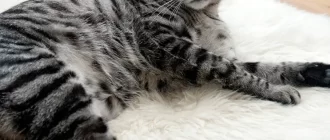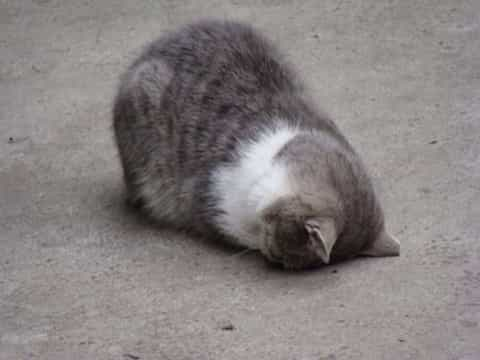Urinary incontinence is one of the most common medical issues that affect cats. This condition is characterized by the uncontrollable and involuntary leakage of urine from the bladder. It can occur in cats of all ages, but it’s more common in older felines. Apart from being unpleasant and inconvenient for both pets and owners, urinary incontinence can also be a sign of serious underlying medical conditions that require prompt attention.
We’ll explore the causes, symptoms, diagnosis, treatment options, and preventative measures pet owners can take to manage urinary incontinence in their cats effectively.
Types of Incontinence in Cats
Types of Incontinence in Cats can be classified as disorders of the storage phase of micturition, except for overflow incontinence. The most common form is Urge Incontinence, which is caused by urinary crystals and stones, bacterial bladder infections, and is often associated with frequent urination. Neurogenic Incontinence is caused by an underlying neurological disease, while Congenital Incontinence is due to a structural abnormality present at birth.
Another form of incontinence is Stress Incontinence, which occurs when there is pressure on the bladder such as during exercise, coughing, or sneezing. Most feline incontinence cases are due to urethral obstruction, bladder hypercontractility, or partial urethral obstruction. Understanding the type of incontinence present in your cat is crucial in determining the appropriate treatment and management plan.
Breeds under the Risk of the Issue
Research has shown that certain cat breeds are more prone to urinary incontinence than others. Large cat breeds like Maine Coons, Persians, and Himalayans are at a higher risk of developing urinary incontinence due to their physiology.
Additionally, breeds with long hair, like Scottish Folds, can experience urinary incontinence due to difficulties in self-grooming, which leads to urinary tract infections. In contrast, Siamese and Balinese cats tend to have a lower risk of urinary incontinence.
It is essential to note that these breed predispositions do not necessarily mean that cats of other breeds cannot develop urinary incontinence. Regardless of the breed, it is important to monitor your cat’s urinary health regularly and seek veterinary care if any symptoms arise.
Symptoms and Signs
As a cat owner, it’s important to be able to recognize the symptoms and signs of urinary incontinence in cats. The first signs of this issue are usually puddles of urine on the carpet, furniture, and around the home. Look for wet spots or stains that may be in unusual places. Your cat may also start peeing outside of the litter box, or you may notice that their litter box is constantly wet.
Another sign to watch out for is your cat urinating as they sleep, or passing stool involuntarily. Additionally, cats with urinary incontinence may constantly be licking their hindquarters a little too often, which can result in hair loss or skin irritation. If you see any of these signs or symptoms, take your cat to the vet for a check-up to determine the cause.
It’s important to note that urinary incontinence is rare in cats, so if you notice any of these signs, it’s best to act fast. Knowing the symptoms and signs of urinary incontinence can help you catch this issue early on and give your cat the care they need.
Main Causes of Urinary Incontinence in Cats
Urinary incontinence in cats can have a variety of underlying causes. Understanding these causes can help pet owners identify and address the issue effectively.
One of the most common causes of urinary incontinence in cats is obesity. When cats are overweight, the extra strain on their bladder can make it difficult for them to control their urination. Additionally, neutering is another primary risk factor for incontinence, although most cats will not develop this issue.
Neurogenic disease, congenital anatomic abnormality, bladder hypercontractility, urethral incompetence, partial urethral obstruction, bladder neck, or injury to the spinal column due to trauma, are other potential causes of urinary incontinence in cats. Feline diabetes can also affect cats, and two common symptoms include peeing in higher volumes and excessive peeing, which may give the appearance of incontinence.
Urge incontinence is also a common form of feline incontinence, which is usually caused by bacterial bladder infections, urinary crystals, or urinary stones. It is often associated with frequent urination. The underlying cause in feline urge incontinence is thought to be related to disruption of specialized portions of bladder smooth muscle cells, so-called tight junctions.
Understanding the causes of urinary incontinence in cats is essential to appropriately addressing the issue. By identifying the underlying cause, pet owners can work with their veterinarian to develop the right treatment plan for their feline companion.
Risk Factors
Risk factors play a crucial role in the development of urinary incontinence in cats. As discussed in the previous sections, this condition has a variety of causes including anatomical abnormalities, bladder inflammation, and neurological disorders. However, there are certain risk factors that can increase the likelihood of a cat developing urinary incontinence.
Stress, both emotional and environmental, multi-cat households, and sudden changes in daily routine can all increase the risk of urinary incontinence in cats. Additionally, certain breeds such as Siamese and Himalayan cats are more susceptible to this condition.
If you have a cat that falls under these risk factors, it’s important to be aware of the signs and symptoms of urinary incontinence. This includes frequent urination, dribbling urine, and accidents outside of the litter box.
While it’s impossible to completely eliminate the risk of urinary incontinence in cats, there are preventative measures that can be taken. Ensuring that your cat has access to clean water and a healthy diet can help minimize the chances of bladder inflammation and potential infection. Additionally, keeping a regular routine and minimizing stress can also be beneficial.
List of Treatment Options
To treat urinary incontinence in cats, there are several treatment options available based on the underlying cause. For infectious urinary incontinence, antibiotics and anti-inflammatory medications, along with prescription diets or supplements for stool management, may be prescribed. In some cases, catheterization may also be necessary. Bethanachol, a parasympathomimetic drug, is another option that could improve detrusor muscle function. Phenylpropanolamine is another medication often used to treat urinary incontinence in cats.
Other treatment options may depend on the specific underlying cause of the condition. For example, hormone replacement therapy may be recommended for cats that have been neutered. In cases where obesity is the cause, weight management and dietary changes may be helpful.
It is important to note that while medications and treatments can help manage urinary incontinence in cats, they do not necessarily cure the condition entirely. Therefore, lifestyle changes such as regular exercise, minimizing stress and anxiety, and providing frequent access to litter boxes may also be recommended to help manage the condition. By working with a veterinarian to identify the underlying cause and develop an appropriate treatment plan, cat owners can help their furry companions stay comfortable and happy despite urinary incontinence.
Preventing Urinary Incontinence in Cats
While urinary incontinence in cats is not common, there are steps you can take to reduce the risk of this issue occurring in your furry friend. One of the most effective ways to prevent urinary incontinence in cats is by maintaining their overall health and wellbeing. This can be accomplished by providing a balanced diet, fresh water, and regular exercise.
Another way to prevent urinary incontinence is by addressing potential underlying conditions early on. Visiting the veterinarian for regular check-ups and addressing any health concerns promptly can help prevent incontinence caused by urinary tract infections or other health conditions.
It is also essential to keep your cat’s litter box clean and accessible. This ensures that your cat doesn’t develop any urinary tract infections or discomfort that could contribute to urinary incontinence. Additionally, providing multiple litter boxes throughout your home can encourage your cat to use them and reduce the risk of inappropriate elimination.
Lifestyle Changes for Managing Urinary Incontinence in Cats
In order to manage urinary incontinence in cats, pet owners must make certain lifestyle changes that can help their furry friend become more comfortable and happy. One effective option is to create a safe and secure environment where the cat can move and explore with ease. This means keeping the litter box clean, accessible and in an area that the cat can easily reach. Additionally, providing high-quality food and ample water sources can help maintain proper hydration and prevent urinary tract infections.
Another lifestyle change is to establish a routine, especially for feeding and bathroom time. This consistency can help the cat become more comfortable and feel more familiar with their surroundings. Moreover, it is critical to provide an enriching and engaging environment that will help reduce stress levels for cats. Cat owners should also consider introducing more physical activity such as playing and interacting with their pet.
Finally, it is essential to ensure that your cat receives proper medical care for any underlying conditions that might be causing urinary incontinence. This includes regular vet visits and medication, when required. By following these lifestyle changes, pet owners can help their cat avoid or manage urinary incontinence and improve their quality of life.





